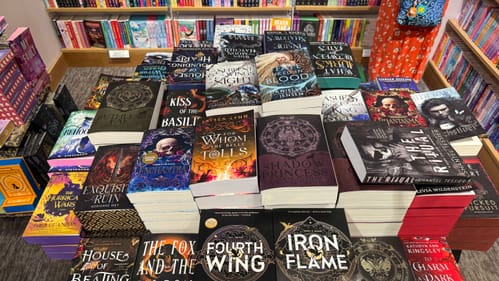Stay in the Loop
BSR publishes on a weekly schedule, with an email newsletter every Wednesday and Thursday morning. There’s no paywall, and subscribing is always free.
Is romantasy regressive?
The romantasy genre subverts women’s agency when we need it the most

I don’t know a single woman who learned anything meaningful about sex from her school’s sex-ed classes—if they were even able to attend. My friend Nina’s religious parents wouldn’t allow her to take part at all. So Nina and I trawled our school library for something useful and found the iconic bodice ripper Outlander.
Sitting in a dark corner of that library, we read the novel aloud to each other in whispered tones, devouring the violent historical fiction as much as the graphic and often grotesque sex scenes.
Claire, a British WWII nurse who time-travels to 18th-century Scotland, where she falls in love with a Highland laird, is a fearless, swashbuckling protagonist. She wields her intelligence and sexuality with abandon, but is shockingly forgiving of acts of violence, abuse, and misogyny. Reading Outlander, I felt excitement and outrage.
Enter ACOTAR
Nina and I continued our library search for salacious novels. Years later, we found Sarah J. Maas’s A Court of Thorns and Roses (ACOTAR) on the shelves, the first in a series of novels about an illiterate 19-year-old, Feyre, who gets kidnapped into faerie land only to fall in love with her kidnapper and get roped into saving his world through an implausible series of trials.
While the bodice rippers and their more buttoned-up Regency romance cousins were scandalous, taboo, and rife with violence, ACOTAR has a convoluted story that sells a heavily sanitized, even childlike portrayal of sexuality and desire. Reading ACOTAR, I felt … nothing.
Published in 2015, ACOTAR would soon become the blueprint for the bestselling romantasy genre, a TikTok-fueled romance/fantasy mashup wildly popular with women readers. Now, it’s impossible to walk into most bookstores without encountering an “as seen on BookTok” display with hit romantasy novels like ACOTAR, Fourth Wing, and Quicksilver.
The bodice ripper had something to say
Today, “bodice ripper” has become synonymous with historical and Regency romance, but it is defined as a historical or Gothic romance where the heroine typically faces violence. In their heyday in the 1970s and 1980s, bodice rippers contended with dark themes, especially regarding consent. 1972’s The Flame and the Flower, often called the first bodice ripper, is rife with the threat of sexual violence, which is eventually perpetrated by the male love interest.
These novels coincided with emerging cultural conversations on consent and autonomy for women, and they faced a deep-rooted American puritanism. Amid this sexual landscape, many women felt comfortable enjoying sexual content only if some level of autonomy was removed in order to preserve their perceived moral and sexual purity.
Bodice rippers were scandalous not only for their portrayals of brazen female sexuality and passion, but also for engaging with relevant cultural issues. Novels like The Flame and the Flower contend with marital rape long before it was nationally outlawed in 1993. These books didn't always get things right, but they did exist in conversation with the world around them.
War and suffering, sans social realities
But romantasy takes you out of the real world in every sense. Readers enter a strange landscape riddled with inconsistencies, trying to make peace with the cognitive dissonance of a fantastical world where war and suffering exist, but not misogyny, homophobia, or racism—except selectively when useful for the plot.

Unlike most romance genres, romantasy has the freedom to create the backdrop of its story, yet these novels are often ill-constructed at best, or purposely exclusionary at worst. Though imperfect and beholden to the historical backdrop, bodice rippers and Regency romance novels include a diverse cast of characters. In novels like Devil Takes a Bride, characters become good or bad based on whether or not they’re abolitionists. In contrast, most romantasy sticks to uncomplicated narratives by keeping its characters white (in her Writer’s Digest explainer on romantasy, M.K. Lobb bemoans the genre’s “glaring” lack of diversity).
The constructed worlds of most romantasy novels feel stripped of any real-world social and political context, limiting their ability to explore their own themes. A deeply underwhelming sex scene between Feyre and the 1000-year-old faerie king (“High Lord”) in the third ACOTAR novel demonstrates this. “His growls of pleasure filled the tent, drowning out the distant cries of the injured and dying,” Maas writes of the king whose people are on the battlefield in what is supposed to be the novel’s political climax.
The fated mate
Where fantasy elements intersect with romance, they often force proximity between the intended couple. In the ACOTAR series, this culminates in the fated mate trope, which in one of the books involves a woman being involuntarily turned into a faerie and told that a man she just met is her fated mate. In Fourth Wing, where human warriors partner with dragons, the protagonists are influenced by their dragons’ sexual relationship.
This removal of autonomy and blurring of consent is less about a physical violation than an emotional one. Women today have more freedom than ever to choose their partners, yet romantasy novels depict a regressive world in which that choice is taken from them. The protagonists have little choice in who they love or which worlds they inhabit. Even the magical powers they gain are often against their will.
Novel sex ed
Literature is an important touchstone, for young women especially, in understanding sex and desire. Outlander made me question the world around me as much as it informed my budding notions of sex. Today, I imagine young women finding romantasy instead, which pushes pervasive cultural concepts of women as passive and powerless in their relationships and in the world around them.
More than ever, women’s sexual choices and sexual health intersect with societal, cultural, and political issues. A genre marketed to women that makes no effort to contend with these issues does serious disservice to its readers. I hope readers who find books like the ACOTAR series reject passive, sanitized portrayals of female sexuality and the fallacy that our sex lives exist in a social, cultural, or political vacuum. Ultimately, the only theme romantasy tackles that operates in both fiction and reality is that women are expected, above all else, to endure.
Sign up for our newsletter
All of the week's new articles, all in one place. Sign up for the free weekly BSR newsletters, and don't miss a conversation.

 Chhaya Nayyar
Chhaya Nayyar